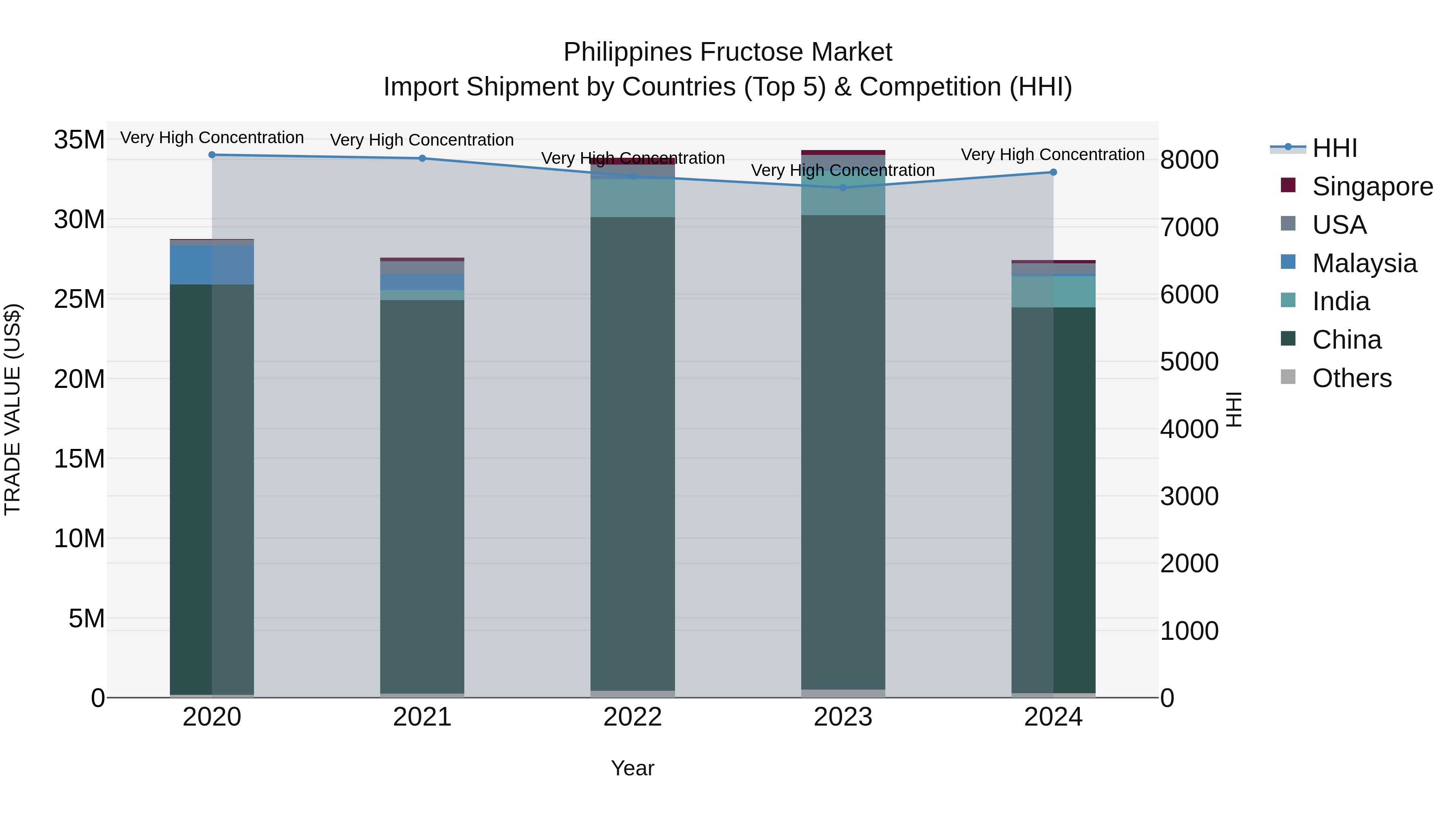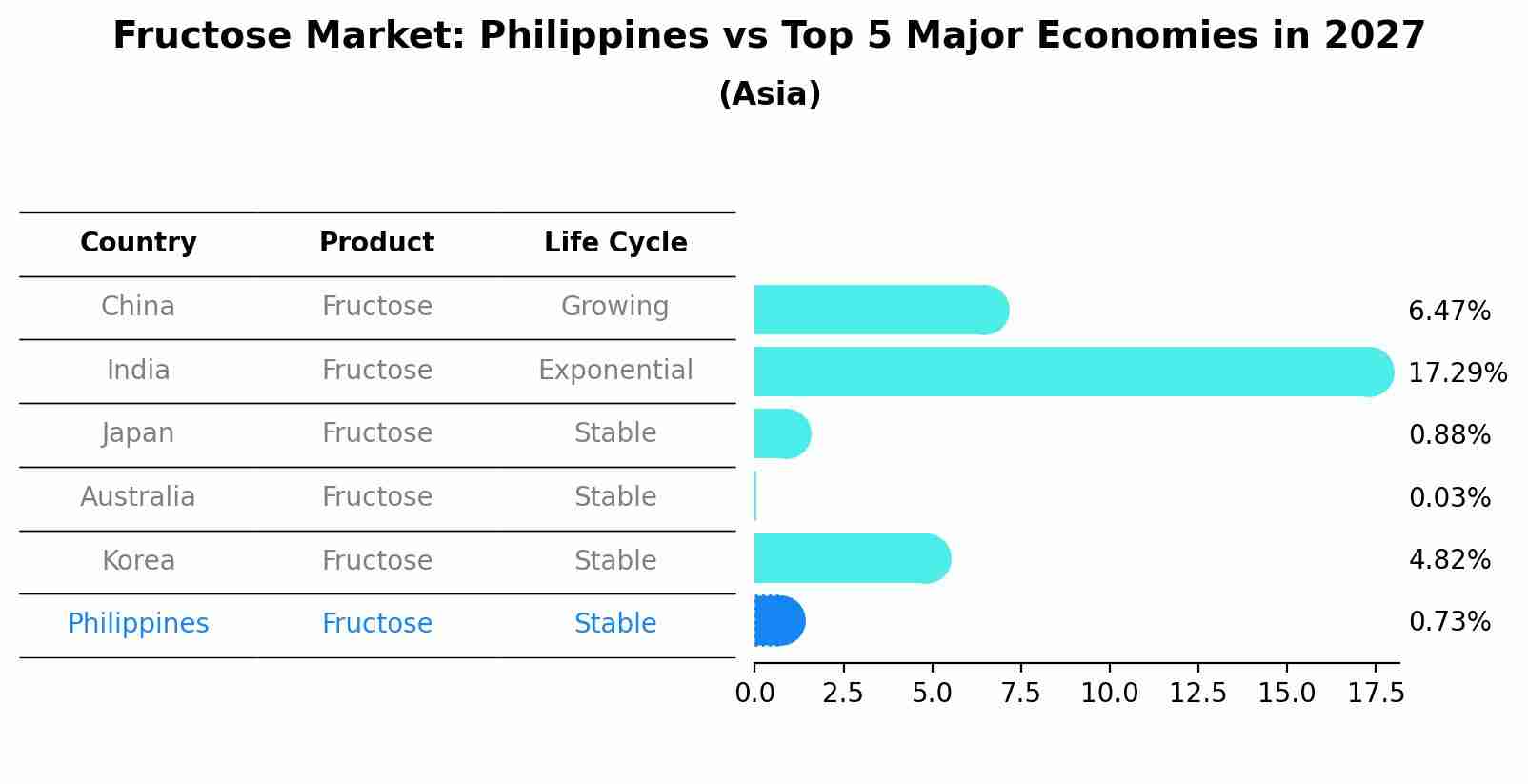Philippines Fructose Market (2025-2031) Outlook | Companies, Share, Growth, Value, Forecast, Trends, Size, Industry, Analysis & Revenue
| Product Code: ETC106248 | Publication Date: Jun 2021 | Updated Date: Nov 2025 | Product Type: Report | |
| Publisher: 6Wresearch | Author: Ravi Bhandari | No. of Pages: 70 | No. of Figures: 35 | No. of Tables: 5 |
Philippines Fructose Market Top 5 Importing Countries and Market Competition (HHI) Analysis
Despite the high concentration of fructose import shipments to the Philippines from top exporting countries such as China, India, USA, Singapore, and Malaysia, the industry experienced a decline with a negative CAGR of -1.16% from 2020 to 2024. Furthermore, the growth rate plummeted by -20.04% in 2024 compared to the previous year. This data suggests a challenging market environment for fructose importers in the Philippines, potentially influenced by various factors including economic conditions, trade policies, and consumer preferences. Continuous monitoring and strategic adjustments may be necessary for stakeholders in the industry to navigate these dynamics effectively.

Fructose Market: Philippines vs Top 5 Major Economies in 2027 (Asia)
By 2027, the Fructose market in Philippines is anticipated to reach a growth rate of 0.73%, as part of an increasingly competitive Asia region, where China remains at the forefront, supported by India, Japan, Australia and South Korea, driving innovations and market adoption across sectors.

Philippines Fructose Market Synopsis
The Philippines fructose market is expected to grow more in the years to come, and it is registering a CAGR of 8.5%. Growing consumer preference for low-calorie sweeteners coupled with increasing consumption of processed food products is driving the growth of fructose market in this country. Increasing investment on research & development activities related to alternative sweeteners has further created an opportunity for companies operating in this industry space over the past few years.
Drivers of the market
The Philippines fructose market is influenced by changing dietary patterns, consumer preferences for healthier alternatives to traditional sweeteners, and the rising demand for low-calorie and natural sweetening options. As concerns about excessive sugar consumption and its potential health impacts grow, fructose, often derived from fruits, is positioned as a natural alternative. The demand for fructose is also driven by its use in food and beverage industries for formulating reduced-sugar and low-calorie products, aligning with the health-conscious choices of consumers.
Challenges of the market
The Philippines fructose market, influenced by dietary trends and food and beverage formulations, might face challenges related to health perceptions. High consumption of fructose has been associated with health issues, including obesity and metabolic disorders. As health-conscious consumers seek healthier alternatives, fructose`s reputation might impact its market demand. Moreover, the availability and pricing of fructose relative to other sweeteners could affect its usage in various food and beverage products. The industry might need to address these challenges by emphasizing the responsible use of fructose in formulations, exploring alternative sweeteners, and focusing on product labeling to inform consumers about the nutritional content.
Covid-19 Impact of the market
The Philippines fructose market faced challenges amid the COVID-19 pandemic. Fructose is used in various industries, including food and beverages. The disruptions in supply chains, reduced production of processed foods, and shifts in consumer preferences influenced the demand for fructose-containing products. As food production and consumption patterns stabilize, the fructose market is anticipated to recover. The market`s revival will be driven by the continued need for sweeteners in diverse food and beverage applications.
Key Players of the market
The Philippines fructose market, involving the production and distribution of a natural sweetener, feature notable players like AJINOMOTO Philippines Corporation. This company offers a wide range of food ingredients, including fructose-based sweeteners. Another key participant could be Philippine Bio-Industries, contributing to the market by supplying fructose products for food and beverage applications, shaping the availability of sweetening solutions.
Key Highlights of the Report:
- Philippines Fructose Market Outlook
- Market Size of Philippines Fructose Market, 2024
- Forecast of Philippines Fructose Market, 2031
- Historical Data and Forecast of Philippines Fructose Revenues & Volume for the Period 2021-2031
- Philippines Fructose Market Trend Evolution
- Philippines Fructose Market Drivers and Challenges
- Philippines Fructose Price Trends
- Philippines Fructose Porter's Five Forces
- Philippines Fructose Industry Life Cycle
- Historical Data and Forecast of Philippines Fructose Market Revenues & Volume By Product for the Period 2021-2031
- Historical Data and Forecast of Philippines Fructose Market Revenues & Volume By High Fructose Corn Syrup for the Period 2021-2031
- Historical Data and Forecast of Philippines Fructose Market Revenues & Volume By Fructose Syrups for the Period 2021-2031
- Historical Data and Forecast of Philippines Fructose Market Revenues & Volume By Fructose Solids for the Period 2021-2031
- Historical Data and Forecast of Philippines Fructose Market Revenues & Volume By Application for the Period 2021-2031
- Historical Data and Forecast of Philippines Fructose Market Revenues & Volume By Beverages for the Period 2021-2031
- Historical Data and Forecast of Philippines Fructose Market Revenues & Volume By Processed Foods for the Period 2021-2031
- Historical Data and Forecast of Philippines Fructose Market Revenues & Volume By Dairy Products for the Period 2021-2031
- Historical Data and Forecast of Philippines Fructose Market Revenues & Volume By Confectionary for the Period 2021-2031
- Historical Data and Forecast of Philippines Fructose Market Revenues & Volume By Bakery & Cereals for the Period 2021-2031
- Historical Data and Forecast of Philippines Fructose Market Revenues & Volume By Others for the Period 2021-2031
- Philippines Fructose Import Export Trade Statistics
- Market Opportunity Assessment By Product
- Market Opportunity Assessment By Application
- Philippines Fructose Top Companies Market Share
- Philippines Fructose Competitive Benchmarking By Technical and Operational Parameters
- Philippines Fructose Company Profiles
- Philippines Fructose Key Strategic Recommendations
Frequently Asked Questions About the Market Study (FAQs):
1 Executive Summary |
2 Introduction |
2.1 Key Highlights of the Report |
2.2 Report Description |
2.3 Market Scope & Segmentation |
2.4 Research Methodology |
2.5 Assumptions |
3 Philippines Fructose Market Overview |
3.1 Philippines Country Macro Economic Indicators |
3.2 Philippines Fructose Market Revenues & Volume, 2021 & 2031F |
3.3 Philippines Fructose Market - Industry Life Cycle |
3.4 Philippines Fructose Market - Porter's Five Forces |
3.5 Philippines Fructose Market Revenues & Volume Share, By Product, 2021 & 2031F |
3.6 Philippines Fructose Market Revenues & Volume Share, By Application, 2021 & 2031F |
4 Philippines Fructose Market Dynamics |
4.1 Impact Analysis |
4.2 Market Drivers |
4.3 Market Restraints |
5 Philippines Fructose Market Trends |
6 Philippines Fructose Market, By Types |
6.1 Philippines Fructose Market, By Product |
6.1.1 Overview and Analysis |
6.1.2 Philippines Fructose Market Revenues & Volume, By Product, 2021-2031F |
6.1.3 Philippines Fructose Market Revenues & Volume, By High Fructose Corn Syrup, 2021-2031F |
6.1.4 Philippines Fructose Market Revenues & Volume, By Fructose Syrups, 2021-2031F |
6.1.5 Philippines Fructose Market Revenues & Volume, By Fructose Solids, 2021-2031F |
6.2 Philippines Fructose Market, By Application |
6.2.1 Overview and Analysis |
6.2.2 Philippines Fructose Market Revenues & Volume, By Beverages, 2021-2031F |
6.2.3 Philippines Fructose Market Revenues & Volume, By Processed Foods, 2021-2031F |
6.2.4 Philippines Fructose Market Revenues & Volume, By Dairy Products, 2021-2031F |
6.2.5 Philippines Fructose Market Revenues & Volume, By Confectionary, 2021-2031F |
6.2.6 Philippines Fructose Market Revenues & Volume, By Bakery & Cereals, 2021-2031F |
6.2.7 Philippines Fructose Market Revenues & Volume, By Others, 2021-2031F |
7 Philippines Fructose Market Import-Export Trade Statistics |
7.1 Philippines Fructose Market Export to Major Countries |
7.2 Philippines Fructose Market Imports from Major Countries |
8 Philippines Fructose Market Key Performance Indicators |
9 Philippines Fructose Market - Opportunity Assessment |
9.1 Philippines Fructose Market Opportunity Assessment, By Product, 2021 & 2031F |
9.2 Philippines Fructose Market Opportunity Assessment, By Application, 2021 & 2031F |
10 Philippines Fructose Market - Competitive Landscape |
10.1 Philippines Fructose Market Revenue Share, By Companies, 2024 |
10.2 Philippines Fructose Market Competitive Benchmarking, By Operating and Technical Parameters |
11 Company Profiles |
12 Recommendations |
13 Disclaimer |
- Single User License$ 1,995
- Department License$ 2,400
- Site License$ 3,120
- Global License$ 3,795
Search
Thought Leadership and Analyst Meet
Our Clients
Related Reports
- Canada Oil and Gas Market (2026-2032) | Share, Segmentation, Value, Industry, Trends, Forecast, Analysis, Size & Revenue, Growth, Competitive Landscape, Outlook, Companies
- Germany Breakfast Food Market (2026-2032) | Industry, Share, Growth, Size, Companies, Value, Analysis, Revenue, Trends, Forecast & Outlook
- Australia Briquette Market (2025-2031) | Growth, Size, Revenue, Forecast, Analysis, Trends, Value, Share, Industry & Companies
- Vietnam System Integrator Market (2025-2031) | Size, Companies, Analysis, Industry, Value, Forecast, Growth, Trends, Revenue & Share
- ASEAN and Thailand Brain Health Supplements Market (2025-2031) | Strategy, Consumer Insights, Analysis, Investment Trends, Opportunities, Growth, Size, Share, Industry, Revenue, Segments, Value, Segmentation, Supply, Forecast, Restraints, Outlook, Competition, Drivers, Trends, Demand, Pricing Analysis, Competitive, Strategic Insights, Companies, Challenges
- ASEAN Bearings Market (2025-2031) | Strategy, Consumer Insights, Analysis, Investment Trends, Opportunities, Growth, Size, Share, Industry, Revenue, Segments, Value, Segmentation, Supply, Forecast, Restraints, Outlook, Competition, Drivers, Trends, Demand, Pricing Analysis, Competitive, Strategic Insights, Companies, Challenges
- Europe Flooring Market (2025-2031) | Outlook, Share, Industry, Trends, Forecast, Companies, Revenue, Size, Analysis, Growth & Value
- Saudi Arabia Manlift Market (2025-2031) | Outlook, Size, Growth, Trends, Companies, Industry, Revenue, Value, Share, Forecast & Analysis
- Uganda Excavator, Crane, and Wheel Loaders Market (2025-2031) | Strategy, Consumer Insights, Analysis, Investment Trends, Opportunities, Growth, Size, Share, Industry, Revenue, Segments, Value, Segmentation, Supply, Forecast, Restraints, Outlook, Competition, Drivers, Trends, Demand, Pricing Analysis, Competitive, Strategic Insights, Companies, Challenges
- Rwanda Excavator, Crane, and Wheel Loaders Market (2025-2031) | Strategy, Consumer Insights, Analysis, Investment Trends, Opportunities, Growth, Size, Share, Industry, Revenue, Segments, Value, Segmentation, Supply, Forecast, Restraints, Outlook, Competition, Drivers, Trends, Demand, Pricing Analysis, Competitive, Strategic Insights, Companies, Challenges
Industry Events and Analyst Meet
Whitepaper
- Middle East & Africa Commercial Security Market Click here to view more.
- Middle East & Africa Fire Safety Systems & Equipment Market Click here to view more.
- GCC Drone Market Click here to view more.
- Middle East Lighting Fixture Market Click here to view more.
- GCC Physical & Perimeter Security Market Click here to view more.
6WResearch In News
- Doha a strategic location for EV manufacturing hub: IPA Qatar
- Demand for luxury TVs surging in the GCC, says Samsung
- Empowering Growth: The Thriving Journey of Bangladesh’s Cable Industry
- Demand for luxury TVs surging in the GCC, says Samsung
- Video call with a traditional healer? Once unthinkable, it’s now common in South Africa
- Intelligent Buildings To Smooth GCC’s Path To Net Zero


















